“Landfills and the Waste Act implementation – What has changed? ” This was the primary question being asked by IWMSA President, Dr Suzan Oelofse, when she delivered her paper in the Opening Session of the Landfill 2013 Conference, which started on Wednesday 16 October 2013 at the Misty Hills Country Hotel, Muldersdrift, Gauteng.
The Landfills 2013 Conference is being hosted by the Landfill Interest Group of the Institute of Waste Management of Southern Africa (IWMSA) Central Branch, in association with the Geosynthetic Interest Group of South Africa (GIGSA). Dr Oelofse’s paper reports on the latest developments in waste management regulation in South Africa, focusing specifically on the changes that impact landfilling. According to Dr Oelofse,the most important changes as a result of the implementation of the Waste Act, and subsequent development of regulations, norms and standards, is stricter regulation of waste management activities including disposal of waste to landfill. “The fact that the waste management hierarchy is included in the Waste Act and will be implemented through various mechanisms including norms, standards and regulations (Section 69(1)(i)) (RSA, 2008) should result in less recyclable waste finding its way to landfill. It is also expected that the introduction of new technologies may result in a change in composition and characteristics of waste streams being disposed of at landfill.”She highlights that she thinks the most drastic change is expected to come with the implementation of the Waste Classification and Management Regulations, 2013 and as such she contends the approved new approach for assessment of waste for landfill disposal requires more, and more complex, analytical processes which in turn is more costly than the previous system.
“The fact that analyses will in future have to be done at accredited laboratories is another complicating factor. There are a limited number of accredited laboratories available that are equipped to analyse waste samples. Establishing more of these laboratories will be costly as the required equipment does not come cheap. Accreditation of a new laboratory is also not a trivial thing and may take a year or longer to obtain,” warns Dr Oelofse. She adds that the results of the analyses under the new regulations may also have a different outcome as compared to the classification system contained in the Minimum Requirements (DWAF, 1998a) i.e. wastes that were previously classified as hazardous may no longer fall into this category and vice versa. “A change from a previously hazardous waste category to a non-hazardous waste category and vice versa, may have serious implications for landfill operators now having to accept and manage waste streams that were previously not disposed of at their landfills.” However, she contends that the magnitude of the change in waste categories will only become evident with the implementation of the regulations. “Therefore it can only be speculated what the impacts on available landfill airspace, operations, cost and income generation potential of landfills will be.” This is just a glimpse of a multitude of influential conclusions she draws in the paper.







